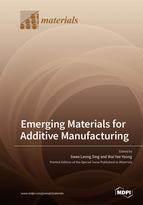Emerging Materials for Additive Manufacturing
A special issue of Materials (ISSN 1996-1944). This special issue belongs to the section "Manufacturing Processes and Systems".
Deadline for manuscript submissions: closed (20 September 2022) | Viewed by 37750
Special Issue Editors
Interests: additive manufacturing; 3D printing; 3D bioprinting; laser–material interactions; laser-based advanced manufacturing
Special Issues, Collections and Topics in MDPI journals
Interests: additive manufacturing; 3D printing; 3D bioprinting
Special Issues, Collections and Topics in MDPI journals
Special Issue Information
Dear Colleagues,
Additive manufacturing (AM), commonly known as 3D printing, has advanced significantly in recent years. With such advancements, AM has proved to be viable in processing established materials for conventional processes, and has also resulted in more opportunities in materials development. Many materials, for example, glass, concrete, composites, magnetic, conductive and food materials, that were considered to be challenging have emerged to be viable using 3D printing.
While many of such materials are still in research and development, 3D printing has no doubt expanded the applicability of such materials. In this Special Issue, state-of-the-art reviews and current research results which focus on new materials for AM will be reported. This includes, but is not limited to, new alloys, composites, polymers, food, concrete, conductive, magnetic and smart materials. Submissions related to novel applications, designs, processes or characterization methods for such materials are also welcomed.
Contributions focused on AM in any of the following topics are of particular interest:
- Novel materials for additive manufacturing
- New processes and machines for materials processing using additive manufacturing
- New applications in 3D printing
- Characterisation techniques for 3D printed materials
- Standards and quality control in materials for 3D printing
Dr. Swee Leong Sing
Prof. Dr. Wai Yee Yeong
Guest Editors
Manuscript Submission Information
Manuscripts should be submitted online at www.mdpi.com by registering and logging in to this website. Once you are registered, click here to go to the submission form. Manuscripts can be submitted until the deadline. All submissions that pass pre-check are peer-reviewed. Accepted papers will be published continuously in the journal (as soon as accepted) and will be listed together on the special issue website. Research articles, review articles as well as short communications are invited. For planned papers, a title and short abstract (about 100 words) can be sent to the Editorial Office for announcement on this website.
Submitted manuscripts should not have been published previously, nor be under consideration for publication elsewhere (except conference proceedings papers). All manuscripts are thoroughly refereed through a single-blind peer-review process. A guide for authors and other relevant information for submission of manuscripts is available on the Instructions for Authors page. Materials is an international peer-reviewed open access semimonthly journal published by MDPI.
Please visit the Instructions for Authors page before submitting a manuscript. The Article Processing Charge (APC) for publication in this open access journal is 2600 CHF (Swiss Francs). Submitted papers should be well formatted and use good English. Authors may use MDPI's English editing service prior to publication or during author revisions.
Keywords
- additive manufacturing
- 3D printing
- multi-materials
- smart materials
- magnetic materials
- ceramics
- biomaterials
- nanomaterials
- composites
- food








